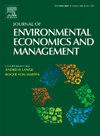怀孕期间接触管道气体连接对儿童发育的影响:来自中国的证据
IF 5.9
3区 经济学
Q1 BUSINESS
Journal of Environmental Economics and Management
Pub Date : 2025-06-02
DOI:10.1016/j.jeem.2025.103195
引用次数: 0
摘要
本文利用中国社区的管道天然气连接项目,估计了家庭在怀孕期间获得清洁燃料对儿童发育的长期影响。我们的异中之差估计表明,在中国,子宫内接触管道气体连接会增加身高与年龄的z得分,并降低0-15岁儿童的发育迟缓和严重发育迟缓率。我们没有发现对体重相关结果有统计学意义的影响。对女孩、贫困儿童和农村儿童的身高影响更大,这表明在怀孕期间建设公共能源基础设施有助于减少儿童发育中的性别、社会经济和城乡差异。出生结果和婴儿健康状况的改善以及家庭投资的增加可能是子宫内接触管道气体连接带来长期健康益处的两个主要潜在机制。我们进一步的计算表明,管道天然气连接计划具有很高的成本效益,应该得到政府的补贴和支持,以增加家庭获得清洁能源的机会。本文章由计算机程序翻译,如有差异,请以英文原文为准。
The impact of exposure to pipeline gas connection during pregnancy on child development: Evidence from China
Using a pipeline gas connection program in Chinese communities, this paper estimates the long-term impact of household access to cleaner fuel during pregnancy on child development. Our difference-in-differences estimates show that in-utero exposure to pipeline gas connection increases height-for-age z-score and reduces the rates of stunting and severe stunting among children aged 0–15 years in China. We do not find statistically significant impacts on weight-related outcomes. The positive effects on child height are larger for girls, poor children, and rural children, suggesting that building public energy infrastructure during pregnancy could help reduce gender, socioeconomic, and urban-rural disparities in child development. The improvement in birth outcomes and infancy health status and the increase in household investment might be two main underlying mechanisms behind the long-term health benefits from in-utero exposure to pipeline gas connection. Our further calculations show that the pipeline gas connection program is highly cost-beneficial and should be subsidized and supported by the government to increase household access to clean energy.
求助全文
通过发布文献求助,成功后即可免费获取论文全文。
去求助
来源期刊
CiteScore
8.00
自引率
4.30%
发文量
91
期刊介绍:
The Journal of Environmental Economics and Management publishes theoretical and empirical papers devoted to specific natural resources and environmental issues. For consideration, papers should (1) contain a substantial element embodying the linkage between economic systems and environmental and natural resources systems or (2) be of substantial importance in understanding the management and/or social control of the economy in its relations with the natural environment. Although the general orientation of the journal is toward economics, interdisciplinary papers by researchers in other fields of interest to resource and environmental economists will be welcomed.

 求助内容:
求助内容: 应助结果提醒方式:
应助结果提醒方式:


